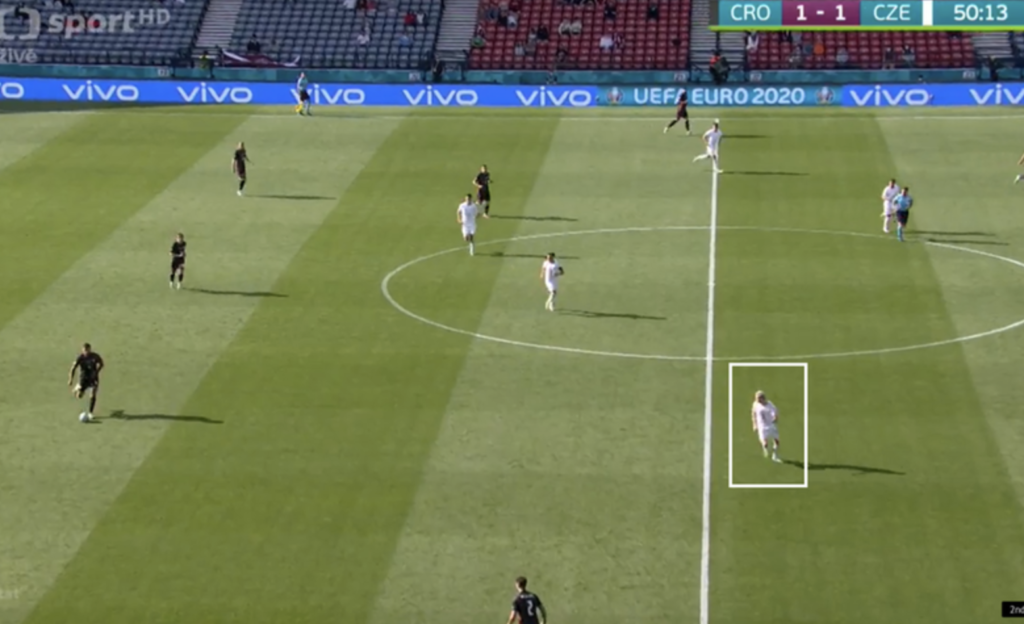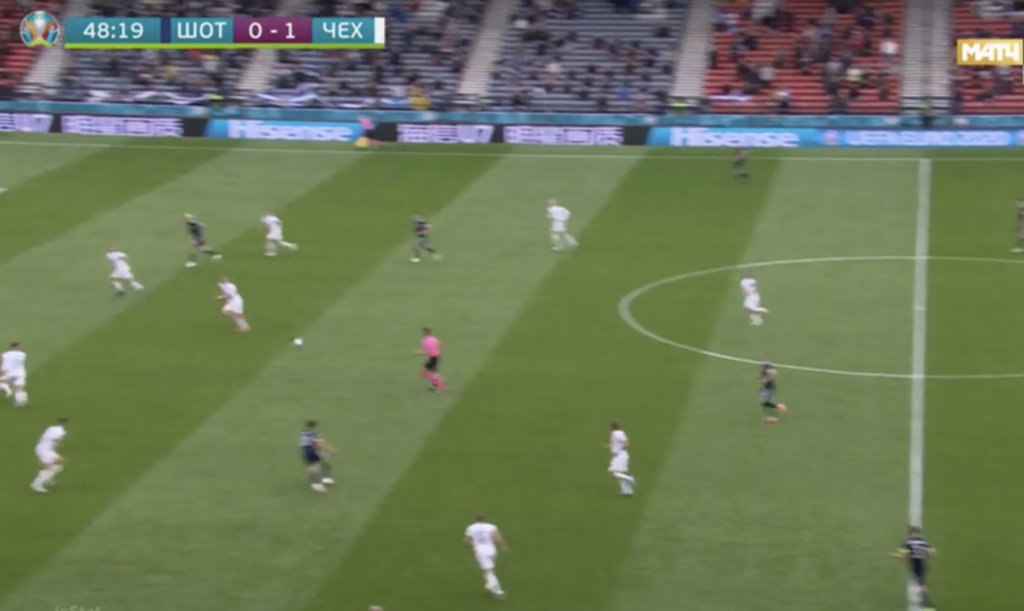When West Ham manager David Moyes was asked about their secret, last season, he responded with: “Soucek and Coufal. They know what is needed to win, to perform top”. The former Everton coach explained how the two would even show up on rest days, to work on their skills. “They simply show the rest of the team what is needed to win.”
And attacking talent Patrick Schick said: “We are not the best team in the world but we can stop the best team in the world. We are very tough to play against. We have a lot of players who leave everything on the pitch.”
At PSV’s trainings ground, there is a saying plastered on the walls: “Working hard beats talent, when talent doesn’t work hard.” And this is exactly the potential pitfall for the Dutch.
The Czech Republic plays a bit like West Ham United. Typical English kick and rush. Goalie Vaclik doesn’t need a lot of invitations to kick the ball long. Goal kicks are usually always kicked long.
Still, the do have well trained patterns for the build up too. This above is what happens a lot. When their opponent drops back, both controlling mids (Soucek and Holes) will drop back to assist the back three with their build up. The reason? Like Liverpool, the Czechs have their most creative player on right back: Coufal. He had the most passes, so far, he has the highest “expected assists” value and the most balls into the box. With those midfielders dropping back, Coufal gets the opportunity to push up and when the opponent doesn’t pressure enough, Coufal can bomb forward and create something for his team. Right back Coufal had seven (7!!) assists last season. They fall into two categories: crosses from the flank and passes into the space between defenders and goalie. Stopping Coufal will be a key mission for Oranje.
Otherwise, the Czechs are well drilled in their set pieces. The only goal at this Euros that didn’t come from a corner or penalty, was Schicks amazing long-range effort, definitely one of the goals of the tournament. Throw ins are important for them too. Left back Jan Boril has a pretty powerful throw in, whereas Coufal can throw a ball like an arrow. Like a pass.
Corner kicks come in different versions too. This is the version that surprised Scotland. Coufal is being found on the edge of the box and he curls the ball in. Jankto and Darida are the usual corner takers and they will look for Soucek, the tall holding mid who scored so many goals in the EPL. Schick is also a very good header of the ball.
The Czechs are happy to use their aerial strength and cross the ball in early. Coach Silhavy might get the max out of his team, but in an attacking sense, they’re definitely not that great. Only Finland, Slovakia and Russia created less opportunities. Per match, the Czechs have an average of 3 attempts on target. Oranje has double that number.
Their work rate is pretty amazing. They can press high and swift and they tend to push their opponent to one side, if possible. They are ranked high in the list of “possession turnaround on the opponent’s half”. Seven of their 28 attempts on goal are the result of this high press. Once a second ball is won by the Czechs on our half, we need to be careful.
Defensively, on their own half, it doesn’t look too good for the Czechs. The space is large, because their full backs are usually gone up field. It will pay off for Holland to not press too high but to play compact and use players like Malen and Memphis and Dumfries to use the space that will open up.
The Czech defenders clearly don’t like to play with space behind them and look uncomfortable when confronted with speed. It really points towards the use of Malen over Weghorst.
The Czechs will wait for the opponent around the centre circle, in a 4-4-2 or 4-2-3-1. Their #10 Darida will sit next to Schick to block the central defenders from their opponent. With their two holding mids, they try to block the pass lines in the spine of the pitch.
The wingers in the team are work horses. Their role is to put pressure high onto the ball when the opponent opts to build up via the wings or wingbacks.
Look at this situation. The Czechs leave the pass to the Croation right back open and once that ball is played, Jankto will push up and press the ball. Jankto does it in such a way that the right back is forced to play back to the centre back. And Jankto can now immediately put pressure on him.
And as the right winger Masopust blocks the pass line to the left, Croatia is forced to go back and start over. The main aim for the Czechs is to slow the game down. And Croatia is forced to play the ball from left to right. The Croatian manager: “We started bad. We played slow and we were running to much with the ball and couldn’t create.” The match against Scotland, who also play 5-3-2, suggest that Stefan de Vrij might be the free man in build up on our side.
Dumfries and Van Aanholt shouldn’t be surprised if Jankto and Masopust will travel all the way back with them, resulting in a 6-3-1 system. They tend to start with zonal marking but as the game progresses and they get a good feel of their opponent’s system, they will go to man marking. The Czechs will adapt and can play the aforementioned systems and a 4-1-4-1 if need be.
There are basically three types of passes that will help us break down their compact style of football. The key is to play forward passes, instead of the defensive passes we saw earlier from Croatia.
The ideal pass is the pass behind their central defenders. Their defenders are simply slow. Striker Mick van Buren, who plays his football in the Czech Republic: “They’re vulnerable at the back. Oranje will need speed. I’m a fan of Weghorst, but I would play Memphis and Malen against these guys.”
A similar scenario, left back Shaw of England is playing the ball towards Sterling who will end up one v one with the goalie.
The second option is to play the ball between the lines. The central defenders tend to go back, due to their lack of speed, and there are always gaps in their midfield. See this example of the Italy game. Italy won 4-0. Players like Daley Blind or Frenkie de Jong should be able to find Malen or Memphis in that space.
The third option is to use the width. Locatelli finds Spinazzola on the left, which stretches the defence, and in this case Insigne becomes the free man.
As a bonus, goalie Vaclik is a very good line keeper with good reflexes but he’s weak with high crosses from the flanks. This can be a weapon for us when we take corners.
The Czechs are not a real counter team, which can cross the length of the pitch with some deadly passes. Like we can, or France. But they do haul the ball long at times, trying to create havoc. Usually, this should worry the Dutch.
My conclusion: we need to watch three things: Schick, set pieces and Coufal. Stopping the right back might be a bit of a problem for us, considering how open we were in earlier matches. Other than that, it shouldn’t be too hard not to concede against them.
Offensively, the key is the forward pass. The Czechs will lure us to spaces where we can’t be dangerous and we need to make sure not to step into that trap. When we manage this and stay out of physical duels, we should be able to break them down.
If we can score early in the match, say in the first 20 minutes and a second goal before half time, we can probably beat them convincingly.
With Malen in the team, I predict a 5-1 win for us. Malen twice, Memphis, Wijnaldum and De Ligt on the score sheet.
Watch the Dutch go for some fun at bowling…













